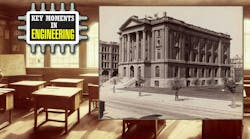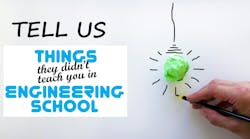The Origins of Electrical Engineering Education
This article is part of the Series Library: Key Moments in Engineering History.
What you’ll learn:
- The beginnings of electrical engineering education.
- How the first EE classes sparked many others to offer similar programs.
- See the original class schedule.
Electrical engineering is often revered as one of the most difficult educational curriculums available. It’s a well-respected, tough, but rewarding field of work. And the areas of expertise have expanded largely over the years.
While all electrical engineers will be required to take courses that cover advanced mathematics, physics, signals and systems, basic circuit analysis, and some computer programming, a full four-year curriculum will generally specialize in a single field of study. For example, some curriculums offer specializations in electromagnetic theory, control systems, power electronics, analog circuit design, digital circuit design, or communication systems, to name a few.
However, it wasn't always this way. The education available has evolved greatly over time, along with technological advances. In fact, the evolution of the electrical engineering curriculum is correlated very well with the development of the electrical industry. To back that up, let's revisit the late 1800s, when electricity was first beginning to make an impact on society.
1870s: The Electrical Era Kicks Off
In the mid-1870s, Alexander Graham Bell experimented with the telephone. In 1876, he was issued a patent for the device, and in 1877, telephones began to be put into service. During this same time, Thomas Edison was famously experimenting with incandescent lights that would eventually go on to replace gas lights and kerosene lanterns.
The success of Edison's lighting system created a demand for electric motors, which Frank Sprague would go on to exploit. Electric motors also began to replace steam engines in industrial plants and allowed for the first electric railway system to be developed in 1888.
On top of that, in the 1880s, alternating-current (AC) systems were beginning to be developed and tested. The first part of the system to emerge was the transformer, followed by AC motors such as the commutating motor and Tesla's induction motor. Then, in 1886, William Stanley, under the direction of George Westinghouse, installed the first AC incandescent lighting system.
As a result, by the year 1900, there was a plethora of electrical breakthroughs and electricity was beginning to have a major impact on everyday life in the United States.
The Emergence of Electrical Engineering Education
During this exciting time of the electrical revolution, there was an apparent need for electrical engineering education. It was Physics Professor Charles Cross at the Massachusetts Institute of Technology (MIT) who first saw the need for electrical engineering education. He sponsored a program to include a few classes in electricity as an "alternative course in physics." This was in 1882, and in 1884, it was renamed Electrical Engineering, although it’s still part of the physics department. It would remain a part of the physics department until 1902, when MIT established its first electrical engineering department (a photogravure of MIT’s Rogers building taken in 1889 is shown in the image above).
At the time, electrical engineering became the third largest branch of engineering to be offered at universities. The other two were mechanical and civil engineering, with many schools also offering a mining engineering curriculum.
Not long after MIT began to offer its first courses focused on electricity, other institutions began following its lead. In 1883, Cornell University announced an electrical engineering program. In 1886, a similar program was established at the University of Missouri, and in 1891, the University of Wisconsin and Stanford University offered such programs.
It only took about a decade before the electrical engineering curriculum gained the interest of the engineering student population. For example, in 1892, the graduating class of MIT consisted of 27% of electrical engineering graduates, a figure that has stayed approximately the same ever since.
However, general knowledge of electricity and electrical phenomena was generally still not well understood. Very little literature and text existed on the topic, and the engineering laboratories consisted mainly of the same equipment found in physics laboratories. A close relationship to the physics curriculum would stay consistent until around the time of the First World War, when various technological breakthroughs led to more advanced courses.
Evolution of Course Offerings: From Basics to Specializations
To get an idea of what one of these very first electrical engineering curriculums was like, a schedule of courses available from the 1904 MIT course catalog is shown below.
First Year (common to all degrees)
- Algebra
- Plane Trigonometry
- Inorganic Chemistry
- Mechanical Drawing
- Freehand Drawing
- French
- Rhetoric and English Composition
- Military Science
Second Year
First Term
- Physics
- Acoustics
- Principles of mechanism
- Mechanical engineering drawing
- Differential calculus
- Descriptive geometry
- Metal turning
- German
- English literature
- European history
Second term
- Physics
- Physics laboratory
- Physical measurements
- Theoretical electricity
- Principles of mechanism
- Valve-gears
- Mechanical engineering drawing
- Integral calculus
- Metal turning
- German
- English literature and composition
Third Year
First term
- Physics
- Physics laboratory
- Theoretical electricity
- Direct current generators
- Steam engineering
- Machine drawing
- Differential equations
- Applied mechanics
- German
- Political economy
Second term
- General electrical measurements
- Dynamo design
- Electrical engineering lab
- Electro-chemistry
- Electrical measuring instruments and methods
- Technical photometry
- Steam engineering
- Applied mechanics
- French
- Political economy and industrial history
- Business law
Fourth year
First term
- Theory of periodic currents
- Direct and alternating current practice
- Methods of dynamo testing
- Storage batteries and applications
- Electrical measuring instruments
- General electrical testing
- Electrical engineering lab
- Steam engineering
- Dynamics of machines
- Theoretical hydraulics
- Engineering laboratory
- Applied mechanics
Second term
- Theory of alternating current machinery
- Direct and alternating current practice
- Telephony
- Telephone engineering
- Dynamo design
- Electrical railroads
- Electrical engineering laboratory
- Engineering laboratory
- Economics of corporations
- Thesis
Comparing Classes Past vs. Present
It’s interesting to note that many required hours were given to languages and economics. Far different than what would be expected today. Still, most of those required classes are similar to what may be expected from a student today. These courses strongly emphasize mathematics and physics. Then, there are the electrical-focused classes such as "theoretical electricity" and corresponding laboratories that are applicable to the time.
However, a heavy emphasis was also placed on mechanical engineering subjects. This is probably due to a lot of attention and focus on electrical machinery like transformers, dynamos, and electric motors.
In addition to the undergraduate studies mentioned above, some schools also offered options for graduate degrees. Before the First World War, though, this was a very uncommon path. For example, between 1900 to 1909, MIT only had six students graduating with Master's degrees and zero with Doctor's degrees.
At the time, some companies actually frowned upon graduate degrees—at the time it was considered that a student prolonged their time spent in school and away from the "real-world" work. Moreover, it can be said that there was no legitimate instruction available for graduate studies at the time, as knowledge of electricity was still in its infancy.
Surge in Tech Advances Leads to Greater EE Interest
The First World War produced many advances in technology and information that would highly impact the fields of engineering. The vacuum tube came into the picture, which also made radio and communications possible. These fields of study began to be the new “hot” subjects in electrical engineering, as the older fields matured and became better understood. In addition, universities were experiencing much more student interest in graduate studies since some of these newer technologies would only be available as graduate courses.
As time progressed, so did the engineering education that was available. Even today, the coursework is highly correlated to the technological advances being made. There are, of course, many parallels to the very first curricula, such as a heavy emphasis on math and physics. But as new hot topics—e.g., artificial intelligence, renewable energies, and machine learning—begin to impact our daily lives, they have also become areas of specialization within engineering programs. So, although the core courses may always be similar, the areas of expertise continue to evolve.
Read more articles in the Series Library: Key Moments in Engineering History.





